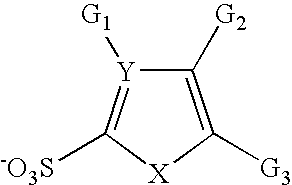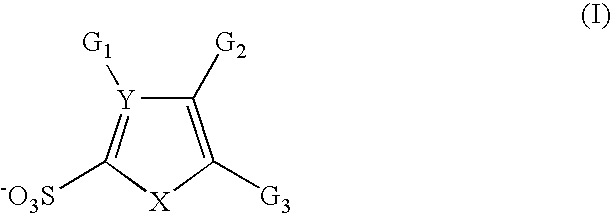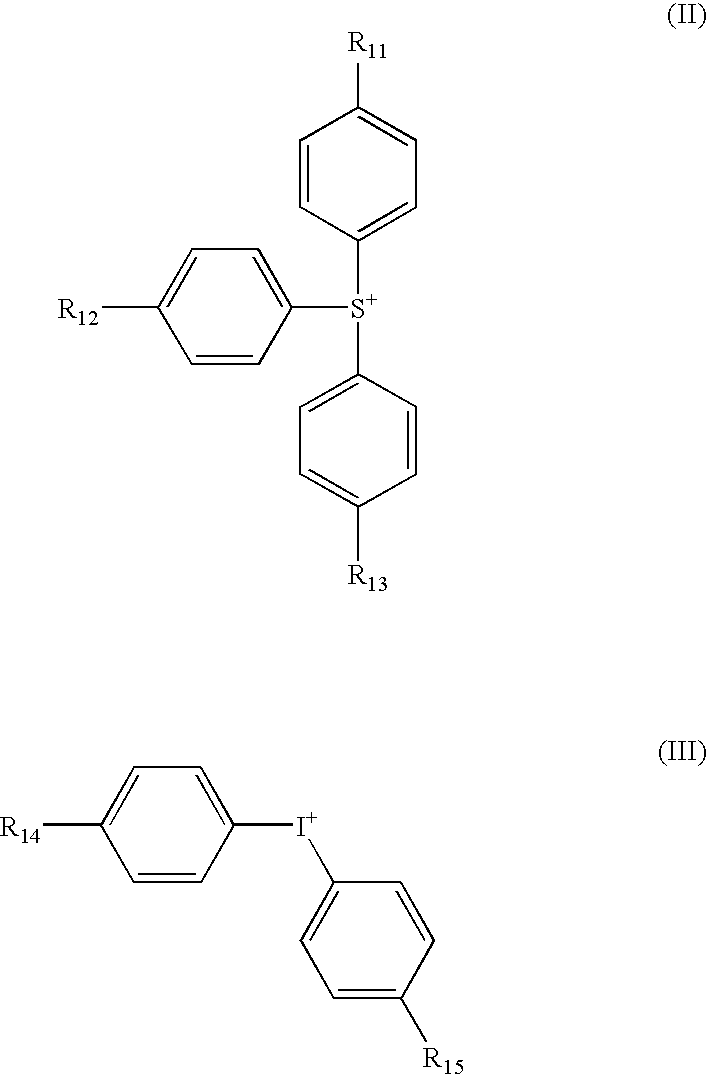Fluorine-free heteroaromatic photoacid generators and photoresist compositions containing the same
- Summary
- Abstract
- Description
- Claims
- Application Information
AI Technical Summary
Benefits of technology
Problems solved by technology
Method used
Image
Examples
example 1
Synthesis of Silver 5-chloro-4-nitrothiophene-2-sulfonate
[0051]To a solution of 5-chloro-4-nitrothiophene-2-sulfonyl chloride (0.393 g, 1.5 mmol) in 15 mL of acetonitrile and 2 mL of water was added silver carbonate (0.414 g, 1.5 mmol) in portions in darkness. The resulting suspension was stirred overnight for 3 days, until no starting material is shown on the thin layer chromatography with an eluant of hexane / ethyl acetate (1:4). The mixture was filtered through half an inch of Celite® and the solid was washed with 3×15 mL acetonitrile. The organic filtrate was combined and organic solvent was removed via rotary evaporator to dryness and thus afforded 0.507 g of viscous solid with a yield of 96.4%. The resulting compound was not purified for further reactions. 1HNMR, d6-DMSO: 7.49 (d, 1H, 0.8 Hz)
example 2
Synthesis of Triphenyl Sulfonium 5-chloro-4-nitrothiophene-2-sulfonate. (TPSTN)
[0052]To a solution of silver 5-chloro-4-nitrothiophene-2-sulfonate (0.25 g, 0.713 mmol) in 15 mL of acetonitrile was added a solution of triphenyl sulfonium bromide (1.373 g, 4 mmol) in 10 mL of acetonitrile and 1 mL of water. The resulting mixture was stirred overnight for 3 days and the solid was allowed to precipitate for 1 day before it was filtered. The organic solvent was removed via rotary evaporator and the residue was re-dissolved in 30 mL of 2-butanone. The resulting solution was washed with 3×5 mL of water, dried over magnesium sulfate and filtered though Celite® and aluminum oxide basic. The organic solvent wad removed via rotary evaporator and dried over vacuum oven to dryness and thus afforded 0.306 g of product with a yield of 85%. 1HNMR, d6-DMSO: 7.90-7.75 (m, 15H), 7.48 (s, 1H). DSC (10° C. / min, nitrogen 5 mL / min) showed no obvious decomposition up to 250° C.
example 3
Synthesis of tert-butylphenyldiphenyl sulfonium 5-chloro-4-nitrothiophene-2-sulfonate. (DPTBPSTN)
[0053]To a solution of silver 5-chloro-4-nitrothiophene-2-sulfonate (0.631 g, 1.8 mmol) in 40 mL of acetonitrile and 2 mL of water was added a solution of tert-butylphenyldiphenyl sulfonium bromide (0.759 g, 1.8 mmol) in 20 mL of acetonitrile and 2 mL of water. The resulting mixture was stirred overnight for 5 days before it was filtered. The organic solvent was removed via rotary evaporator and the residue was re-dissolved in 60 mL of 2-butanone. The resulting solution was washed with 3×10 mL of water, dried over magnesium sulfate and filtered though Celite® and aluminum oxide basic. The organic solvent wad removed via rotary evaporator and dried over vacuum oven to dryness and thus afforded 1.06 g of product with a yield of 92%. 1HNMR, d6-DMSO: 7.87-7.75 (m, 14H), 7.48 (s, 1H), 1.32 (s, 9H). DSC (10° C. / min, nitrogen 5 mL / min) showed no obvious decomposition up to 250° C.
PUM
 Login to View More
Login to View More Abstract
Description
Claims
Application Information
 Login to View More
Login to View More - R&D
- Intellectual Property
- Life Sciences
- Materials
- Tech Scout
- Unparalleled Data Quality
- Higher Quality Content
- 60% Fewer Hallucinations
Browse by: Latest US Patents, China's latest patents, Technical Efficacy Thesaurus, Application Domain, Technology Topic, Popular Technical Reports.
© 2025 PatSnap. All rights reserved.Legal|Privacy policy|Modern Slavery Act Transparency Statement|Sitemap|About US| Contact US: help@patsnap.com



